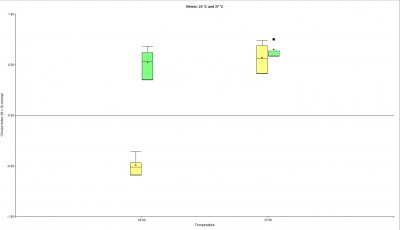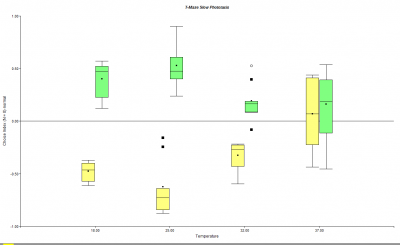Temperature Impact on Phototactic Behavior
on Friday, September 11th, 2015 8:36 | by Amelie Roedel
Using the Wildtype Berlin line of Drosophila melanogaster, I started to examine how flies behave to light while being confronted with different temperatures (4 °C, 14 °C, 25 °C, 32 °C, 37 °C).
The apparatus I use to test the temperature impact on light preference is the T-Maze.
One day before the trials, I clipped off the wings of about 30 – 40 flies under CO2 and put them in a vial together with 30 – 40 flies with wings.
The intervals for the T-Maze are 15 minutes of temperature adaption, 10 minutes of darkness adaption, 30 seconds in the elevator and 30 seconds to choose between darkness and light.
In the rooms with the extreme temperatures of 4°C and 37°C, I had to check if they survive for the spell of time I wanted to test them (~ 26 minutes). In the room with the temperature of 4°C the flies didn’t survive longer than 3 minutes. So I tried to do a T – Maze with a 1 minute adaption for temperature, 1 minute adaption for darkness and again 30 seconds in the elevator and 30 seconds to choose between light and darkness. But the result was not evaluable because the flies didn’t move. So we agreed on not going on with this trial.
In the room with the temperature of 37°C the flies survived perfectly.
After having eight trials for each room, I evaluated the data with “InfoStat” (see figure 1 & 2). The flies without wings went to the darkness and the ones with wings went to the light. In the room with the temperature of 37°C the results were not as we expected (expected Choice Index = 0). I tested them again, but it remained the same. After realizing that the intensity of light could influence the behavior I measured the lux in the different rooms to see if that was a reason for the unexpected results. But even after controlling the intensity of light in all the rooms the behavior didn’t change (see figure 1 and 2).
We decided to retest the flies. I took eight vials holding ~ 40 flies with wings and ~ 40 flies without and tested them in the room with the temperature of 25°C. After the trial I gave them approximately 5 hours to recover from the CO2 treatment and I reused them for the trial in the room with the temperature of 37°C. The result was the same (see figure 3).
We decided to try what would happen if I gave them more time to choose between light and darkness. Now the behavior changed (see figure 4; 3 minutes to choose between light and darkness, “Slow Phototaxis”).
Category: temperature_phototaxis





Leave a Reply